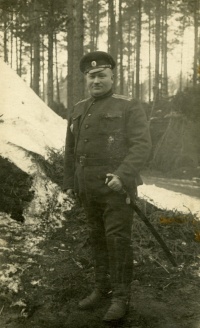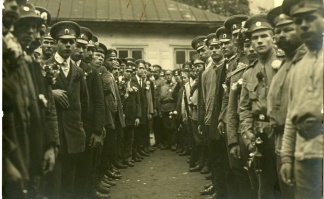Reasons and Course of Formation↑
At the beginning of World War I, general mobilization occurred in Latvia. Those mobilized were incorporated into the units operating in Eastern Prussia. These units were completely destroyed by the German army at the beginning of 1915 in Germany and Poland. Many thousands of soldiers – Latvian by nationality – perished or became prisoners of war.
During the summer of 1915, after the German troops entered the gubernya of Courland (Kurzeme), many hundreds of thousands of Latvian fugitives moved to other parts of what is today Latvia and Russia while the front line was stabilized along the river Daugava. Riga became a frontline city. Along the Eastern Front, warfare transformed into “positional warfare”. In July 1915, the tsar and the highest military command agreed to the formation of Latvian national units similar to the Armenian units and Polish legions. Latvian deputies of the State Duma had made the proposal and agreed that their soldiers would be used at the Northern (Riga) Front, since their soldiers were familiar with the local circumstances. Another important argument for this deployment was the success of two National Guard battalions – consisting mainly of Latvians – during the defense battles against German troops entering the Courland in the spring of 1915.
Permission was given and nine (including one reserve) Russian army riflemen battalions (mobile infantry) were formed. Each of the eight regular, frontline battalions consisted of four companies and five small special units (scouts, machine gunners, signal men, mounted unit and supply unit). There were twenty-seven officers, seven physicists and military clerks, and 1,246 non-commissioned officers and privates in every regular battalion. At the end of 1915, a united hospital of the Latvian Riflemen Battalions was formed. The riflemen were armed mainly with Winchester guns and Maxim machine guns. In addition to Russian, the Latvian language was also allowed in the units. Officers, physicians and military clerks were Latvians too.
The formation of battalions was carried on in tight connection with the Organizational Committee of Latvian Riflemen Battalions. This committee moved forward in a clearly nationalist manner from the very beginning (see for example the liberation of Courland, struggle against the old enemies – Germans, etc.). National slogans were also included in the regimental slogans and their standards. Soldiers entered battalions as volunteers, particularly in the beginning, when the first three battalions consisted almost entirely of volunteers. They were often transferred from other Russian army units. In the autumn of 1915 the battalions consisted of approximately 8,000 soldiers in total. Approximately 90 percent were Latvians, but there were also Estonians, Lithuanians, Russians, Poles and others.
Activities↑
The battalions moved into the battles on the Northern (Riga) Front one after another beginning on 25 October 1915. They demonstrated very high fighting ability despite the great losses they suffered. From the spring of 1916, the battalions were also used in general assaults. In the summer of 1916, the regular battalions were enlarged to six companies, but in November 1916, the battalions were transformed into regiments (each regiment had eight companies and eight special parties), uniting regular regiments into two brigades (in every four regiments). There were fifty officers, seven physicians and military clerks, and 2,505 non-commissioned officers and privates in every regiment. At the beginning of 1917, there were 24,500 soldiers on the front line, and 13,500 in the reserve regiment, located in Tartu (Estonia) and some towns in Northern Latvia. From a structural point of view, the Latvian riflemen’s units had a comparatively high level of education and higher level of average discipline than the units of the Russian army. This was defined by historical peculiarities of so-called Baltic gubernyas.
The most important battles in which the Latvian units took part were in the vicinity of Riga, near Ķekava, Sloka, Ķemeri, and Ikšķile (the defense of the bridgehead on the so-called Nāvessala, or Death Island). The heaviest were the “Christmas battles” in January 1917 when the Russian army tried to break through German lines and liberate Jelgava and the surrounding area. The Latvian riflemen’s regiments were combined into a temporary division under the command of General Major Augusts Misiņš (1863-1940). This division was included in the 6th Siberian Riflemen Corps. At the beginning of the battle, the Russian army and particularly its Latvian units achieved certain success despite the luck of artillery fire support. But common assault was unsuccessful for various reasons, including strong German fortifications and the lack of fighting enthusiasm among some Russian units. During the twenty-five days of fighting, Latvian regiments lost 9,000 killed or wounded soldiers. This was approximately one-third of all Russian army losses during the operation and approximately one-third of all Latvian regiments personnel. This greatly dampened the soldiers’ morale.
Revolutionary Events and Consequences↑
After the February Revolution of 1917, the same processes took place among the Latvian units that were typical for the whole Russian army: political forces competed for influence, overall discipline was lost, soldiers were unwilling to fight, and so on. The processes were greatly strengthened by the riflemen’s previous experience resulting in the conviction that the highest military command’s – and officers’ in general – incompetence had caused the great losses of Latvian military units. In April 1917, the Executive Committee of Latvian Riflemen Regiments (Iskolastrel) was elected. It proclaimed support for the Bolsheviks’ main principles, such as peace without annexations. Nevertheless, most officers and riflemen were not satisfied with such a course of events. Many units recalled their representatives to Iskolastrel, but in August 1917, the National Union of Latvian Soldiers was founded. It declared national, anti-bolshevik aims and slogans. It must be mentioned that national question was essential in Bolshevik propaganda too, for example they promised nations’ right to self-determination.
At the beginning of September 1917, when the German army’s general assault on Riga began, both Latvian brigades, suffering heavy losses, detained the German forces for approximately twenty-four hours, thereby saving the entire Russian 12th Army and preventing the encircling in the city and allowing the 12th Army to freely retreat. The Germans entered Riga on 3 September 1917. Latvian regiments retreated to Livland (Vidzeme, on the front line in the vicinity of Sigulda) where the demoralization of the army continued, although Bolshevik Party propaganda grew in success. Nevertheless, a certain discipline and officers’ power remained in the Latvian regiments in comparison with the army’s other units.
After the Bolshevik coup d’état on 7 November 1917, in which some Latvian riflemen units actively neutralized the staff of the 12th Army in Valka, many officers and soldiers deserted. This process had already begun before the coup d’état. In December 1917, the first Latvian units were sent to Petrograd to guard the new Soviet Russia’s government, The Soviet of People Commissars. At the end of December 1917, the order was issued to form the Latvian Riflemen’s Corp under the command of Jukums Vācietis (1873-1938) but it was not fulfilled because of the general collapse of the Russian army.
In February 1918, German troops occupied all of Latvia. Many riflemen who did not want to go to Russia and remained in their homeland were taken as a prisoners of war and send to camps in Germany. However, all the Latvian regiments had been sent to Russia and fought in the Russian Civil War. To a great degree, the Latvian Soviet Riflemen Division of the Red Army was formed based on these regiments in April 1918. The division had a significant role in the Russian Civil War until the end of 1920, when it was disbanded and most of the Latvians still in its ranks returned to Latvia, the majority of whom were completely disillusioned by Bolshevik policy and ideas.
Ēriks Jēkabsons, University of Latvia
Section Editor: Piotr Szlanta









